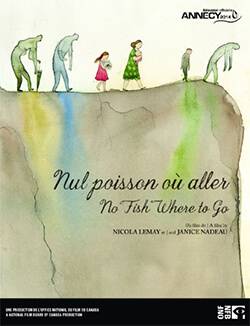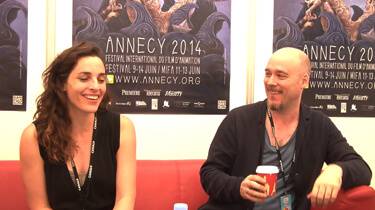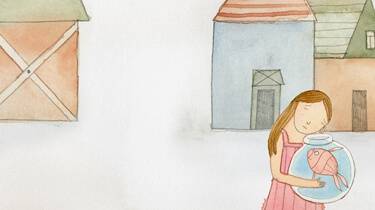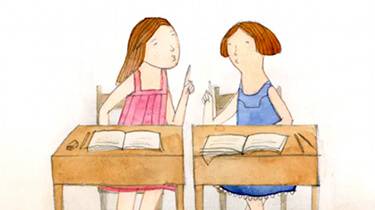Q&A with Nicola Lemay & Janice Nadeau, directors of ‘No Fish Where To Go’
 UPDATE 19/11/2015: No Fish Where to Go is now viewable online in full (stream it below).
UPDATE 19/11/2015: No Fish Where to Go is now viewable online in full (stream it below).
Continuing the ceaseless stride of exceptional animated film projects the NFB has been responsible for, today we take a look at Nul poisson où aller (No Fish Where To Go), a film which explores the inexplicable nature of wartime intolerance and the devastating effects such prejudices can have, seen through the eyes of an exiled family’s young daughter unable to fully comprehend their sudden change of circumstances.
The film was brought into existence by directorial duo Nicola Lemay – an established commercial animator and director (of films including The Star Eater, Private Eyes and Noël Noël) whose relationship with the NFB goes back to 2000 – and Janice Nadeau – an Artistic Director whose background includes children’s book illustration, for which she has been awarded three Governor General’s Awards. The first of these was for her work on the original book on which the film is based, written by Marie-Francine Hébert’s (who also penned the film’s script). Having been met with enthusiasm since its debut, winning the Annecy 2014 FIPRESCI Prize, the film screens in the UK this week at the London International Animation Festival. We met with Janice and Nicola this Summer to learn more about their creative partnership, respective roles on the film and how the project came together.
Had you two ever worked together before this project?
Janice Nadeau: No, that was (producer) Marc Bertrand’s idea.
Nicola Lemay: He’s a matchmaker!
JN: First he fell in love with the book, which was published in 2003. It was the first book that I’d ever illustrated. He had the wish to adapt the book into a film and had previously worked with the scriptwriter Marie-Francine Hébert, so they had a good working relationship already.
NL: A lot of studios wanted to buy the rights to No Fish and Marie-Francine was a bit reluctant because none wanted to work directly with her. When Marc called her up, she knew him and enjoyed his work, he accepted right away to collaborate with her because they knew each other. So we were lucky, it was because of that relationship that the NFB had the advanced privilege of making No Fish.
Which main areas of the film did each of you work on?
JN: I worked more on the artistic aspect and Nicola was working more on the technical side at first, but at the end almost every decision was made together – and we never argued! Nicola was really generous as an experienced filmmaker, he was really open and had no ego to work with me as a beginner.
NL: And she’s so talented, actually I’d told Marc Bertrand at first that part of my mission would be to train Janice, so that ideally at the end of the film she’d became an accomplished filmmaker and be able to make movies on her own. I think I did a fairly good job, Janice is still learning the animation process but she’s getting there. Even though it’s quite sad, she’ll be able to direct her next film on her own, which shows I’ve probably done part of my job correctly.
Were there any major challenges in making the transition from illustration to animation?
JN: At first I was intimidated by the technical aspect of making a film, which is a really big part. Nicola told me “Just do what you’re best at, just translate the emotion in the script through your images”. So that was the path I chose, to be able to respect my way of working and to work at what I’m best at. I was working with a mood board and slowly Nicola started to take my ideas on the board and incorporate them into the storyboard, so we did a lot of back and forth. At the beginning for me the challenge was to think in terms of movement, and what helped me with this were the animated transitions; It felt really natural for me to link one idea to another by creating a new idea that was stronger than the two bases of that idea. So this for me was like continuing the process I was already doing, with putting the words of others to images; Now the images were stronger when they were in motion, so what was the biggest challenge transformed, with Nicola’s help, to something I felt comfortable with.
NL: It was a smart move from Marc Bertrand, because sometimes in the past they would take an illustrator and immediately make him or her a director without any support, trying to learn and make their movie as they went along, which is a very difficult way to learn the process. So basically I took Janice step-by-step and I showed her the classical way of making an animated movie because, especially at the Film Board, every fiilmmaker can do their movie in their own way – without storyboard, without script, starting the animation and seeing how it goes. I always feel that there’s a virtue, like an architect, doing plans before building a house kind of helps! You can build your house as you go along but you may get surprises, or lose a lot of time and money. So I really showed Janice the classical way of making a movie, written script, mood board, storyboard, we kept working on the animatic all the way through to the end, improving it, starting animation on sequences we knew had matured, leaving out sequences we weren’t quite sure about, so there was still time to work on them before starting the animation, because otherwise you might scrap an entire sequence. People don’t think about that, every second of animation is costly, and it’s public money, from Canadian taxpayers.
It was very fun to see recently Janice working on her new project and using this same process without losing a certain freshness or improvisation style. You can work in that structure and still keep improving, it’s not something that’s completely fixed like a blueprint but at least you have a safety net. That structure really worked well for us and I’m really glad that Janice has all the tools now to keep going in that way.
There are a lot of strong themes of societal exclusion, coupled with certain purposeful ambiguities which surround the exact circumstances of the main character. What would you say the story is most about to you?
NL: I like to say, in a nutshell, during a war situation a little girl’s quest is to save her fish. So she grabs her fishtank as they’re going into exile and her quest is to, ideally, find a safe place for it. But of course, things never go as planned. Overall it’s a movie about the absurdity of war, of ethnic genocide, seen through the eyes of a little girl. That’s very important to understand because the film is not necessarily for children, but it’s a movie about children and the whole conflict is seen through the eyes of the main character who’s a child. That’s why you’ll get very few answers about the nature of the war, because a child does not understand the big issues of the grown-ups, all she sees is evil and violence. She’s completely lost and traumatised but still she holds her fishtank and just wants to protect her fish. That’s the same story as the book, in the adaptation we didn’t change any of the story, we just tell it in a different way.
JN: For me the film is also about the chain of hate, how when you’re born in a family that nourishes hate for your neighbour, you don’t know why but you are raised to hate someone just because your family does. So it’s really a simple story, the little girl will free herself with friendship.
NL: Some people may imagine a dark ending, because the ending is a little bit open, you don’t know exactly what will happen, although you suspect that it will be quite tragic. We left the ending open deliberately so you can have hope in humanity because of the children, and you can have hope that, whatever this war is, the new generation will break the chain. So for me it is a very dark movie, even though the watercolours are very light. Visually it’s a very light and bright film but it’s a very tough and dark topic.
From your perspective, was it easy for Marie-Francine to adapt her book to a film script?
NL: Marie-Francine is quite well known at the Film Board because she did a lot of scripts for them. She’s very good with children’s stories and is a very famous local author. Also she knows the difference between cinema and books so she didn’t fall into the trap of just animating the book. Actually, when I read her first draft – and, believe me, I’ve read a lot of scenarios in my life – it was really the best first draft I had ever read in my life! I think it’s because she was thinking about this film for the last ten years, so as soon as she had the chance to write it she knew exactly what to do – what to cut, what to change – and the first draft was impeccable. There were minor adjustments but it was really something solid, a real gem as a first draft.
How did you go about replicating the illustration style for animation?
JN: Everything was done by hand.
NL: It’s all real watercolours.
JN: At first we had a conversation about the technical aspect of the movie…
NL: When you start a project at the Film Board you have a discussion with the technical lead. Early on we were thinking about maybe doing digital watercolours because we’d have more control, but we still wanted to try working with real watercolours.
JN: And for me watercolour is a medium I’m really comfortable with.
NL: She’s amazingly fast.
JN: Also because I was working almost chronologically I was able to control the colour throughout the film. Watercolour was really chosen on purpose for the topic because I think you don’t see a lot of projects about war done in watercolour. It’s usually a stronger, more harsh medium like oils or acrylics, and for me it was interesting to use watercolours because it is related to naivety and youth. It’s very soft, it’s a gentle medium, you can see through it…so it was interesting to trash it as the film goes on.
NL: As we go along there are more smudges. It’s subtle but it’s definitely there, if people look at it twice they’ll see the evolution of the cleanness of the watercolour which gets dirtier and dirtier.
JN: It almost gets used itself as a character in the film.
NL: It completely tells the evolution of the emotional curve, the dramatic curve, the splashes and splatters, it reflects the emotional state of the main two little girls.
JN: At the beginning we did a little walking cycle test and Nicola realised very early that we had to work on threes.
NL: Most films are done on twos, but the watercolour was boiling too much. It was distracting from the story and the visual, so we simply put the animation on threes, eight drawings per second, a bit like the Japanese do, and it felt right. So we still had the real watercolour, we still had a certain fluidity, but it wasn’t boiling too fast to be distracting. I discovered to my surprise that, even though we only had eight drawings per second, the boiling of the watercolour was compensating, adding another moving element to the animation so it didn’t feel jerky or rough, it felt fluid. The other thing that helped was by having Janice, as the inventor of the style of the book, know the medium and the style so well that she was actually as fast as a digital ink and paint artist. So that process actually didn’t slow us down, we finished the movie bang on schedule and within budget, so we couldn’t use the excuse of watercolours slowing us down for more money or time. We actually did everything as planned, it was a delightful surprise!

Janice Nadeau & Nicola Lemay at Annecy 2014
So, all told, this was a successful collaboration?
NL: I think every part of the conception and making of the movie was interesting, at least for us, and honestly everything went really well between us. I’ve been making movies as a director since 2000 and this was probably the most easygoing project that I had to work with, because of Janice and Marc and Marie-Francine.
And if circumstances dictated it, would you work together again?
JN: Oh yes.
NL: Absolutely. Over ten years Janice did a lot of illustration for books, and we’d like to adapt another book that she’s done, eventually. Each of us now have our own independent projects, so hopefully in three years we’ll be able to work together again. I think we’re a good team. When it clicks and you know that you are stronger and better with your partner, it just makes sense to work again on another project.
No Fish Where To Go screens as part of LIAF Competition 4: ‘Looking For Answers’ tonight at 7pm at Barbican Cinemas. For more information visit liaf.org.uk and nfb.ca



